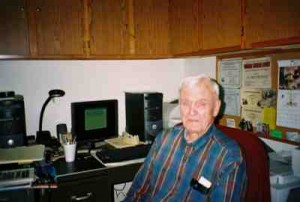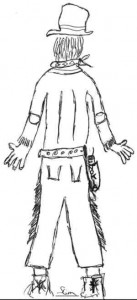Column by Hal Walter
Rural Life – September 2005 – Colorado Central Magazine
IT IS A SOURCE of some minor wonderment to me that nearly every time I drive somewhere — which really isn’t all that often compared to many people — I see the same bright-yellow Humvee on the highway.
I’ve seen this vehicle heading into Westcliffe and out of Westcliffe. I’ve seen it on the road to Pueblo. I’ve seen it leave and enter its actual home driveway. I’ve encountered the vehicle in a variety of time-frames between sunrise and sunset. I have seen this vehicle so many times that I have come to believe this big yellow box on wheels is in perpetual motion at virtually all times, at somewhere between 10 and 12 mpg.
Through a complex algorithm involving mathematical analysis and random physics, and using hypothetical figures of distance, speed and income potential, I have determined there is a 99.99997 percent probability the person driving the yellow Humvee makes or has made more money than myself.
This isn’t to say that the current fuel/energy crisis is the fault of this yellow machine or the person behind its wheel, or even the majority of people who typically vote in a politically backwards manner. Because even if you don’t vote that way at the polling place, you, dear reader, likely vote that way nearly every day, with your wallet, checkbook or even your credit card. And you also vote that way through your actions.
I know I do. And I really loathe this simple truth. I want to change.
The reality of fuel consumption is particularly painful for those of us who have chosen a rural lifestyle. Living a few miles from a population center requires more driving, more fuel, more money. Check it out — a 30-mile round trip to Westcliffe, hardly a mecca for fresh organic produce or vast entertainment, now costs about $5 in my pickup truck. If we drive our Subaru Forester it’s a mere $2.50. A trip to Pueblo is more than $16 in the truck and about $8 in the Subaru.
It doesn’t sound like that much until you start multiplying it by a few trips a week, and then by 52 weeks a year. There’s a song by Jimmy Buffett called “Math Sucks,” and I’ve taken to humming it at the gas pump.
And then there’s my “ranchin'” life. Driving to and from Fairplay or Leadville, hauling a trailer full of burros for the pack-burro races costs at least $50. I recently learned from a hay grower that it takes about a gallon of fuel to produce each bale of hay; then there’s transportation.
Like most people, I like to eat. Consider that on average it takes about a half-gallon of fuel to produce one pound of feedlot beef (this, by the way, is a good reason to request grassfed beef at your local grocery, butcher shop or restaurant). A large proportion of the price of other foods, such as produce, also involves fuel both for production and transportation to the store.
SO WHILE WE usually point to our personal means of transportation, the problem runs much, much deeper. As a nation we are probably the oiliest, greasiest, most gaseous people on Earth.
And we may also be the most stupid, arrogant and hypocritical folks on the planet, too. For despite our complete and total dependence on petroleum products, we talk about promoting freedom and independence throughout the world. The irony of course is that we are slaves to our own consumerism and lifestyle. Because of this we are slaves to other nations. And finally, we are slaves to our own ignorance and laziness, because we have the know-how, the technology, to get ourselves out of this mess, but we do very little about it. Instead, we just keep going to the pump and pumping money into it, meanwhile spending our precious time, money and energy on banalities such as the space shuttle, or investigating steroid use in baseball.
To get back to how this relates to the rural mountain lifestyle, I see a lot of new big houses that have been built in my neighborhood in the past few years when fuel prices were relatively low. Encounters with these new neighbors are largely on the road, waving from their SUVs and big pickup trucks. Most of these people are very well off, judging from their homes, their vehicles, and the amount of time they spend on the road. They are an economy unto themselves.
But when I look around at the Colorado landscape it’s difficult to not take note of the many enterprises that went bust due to economic conditions. There are the many mining towns, some of which hang on today as tourist traps or bedroom communities, and others that are ghost towns. Even a look around the immediate countryside reveals old homesteads, and even entire townsites, where people lived and then vacated for whatever reason. Economics is my best guest.
It makes me wonder how the landscape around here might change when gas hits $5 a gallon or more, and a quick jaunt to town for a latté or chardonnay costs $10, and a major expedition to a Front Range center becomes a $50 drive. Meanwhile the prices of all other consumable goods also climb proportionally. Can these folks just absorb the additional cost ad infinitum?
Or, what if there’s no fuel, or only limited supply? After all, that’s the accepted explanation for the current high fuel prices — the refineries can’t keep up with demand. I’m old enough to remember gas-rationing in the early 1970s. Just imagine how it would affect people if their ration of fuel was only enough to get within 3 or 4 or 8 miles of their homes and still leave enough in the tank to get back to the gas pump for next week’s ration. How many would hike and carry groceries in on a backpack? How many would ride a horse, or hitch up a cart in order to go the last few miles to their ridgetop trophy homes? How many would be willing to do this in a spring blizzard, or on a scorching-hot summer day, or during a howling winter gale?
These are purely hypothetical questions that we may learn the answers to some day soon if the trend in fuel prices and production continues.
As for myself, I have spent a good deal of time recently researching and weighing the merits of biodiesel as a fuel. Biodiesel can be made in small batches from used cooking oil, such as that used in restaurants that make French fries and other fried foods. I’ve discussed sharing the price of a small biodiesel processor with a neighbor, and have been shopping for a diesel pickup. Some friends in the restaurant business have offered their used cooking oil from which to make the fuel. Who knows if this will pan out, but I hope that it does.
If not, it has occurred to me that I own four burros, good for riding and packing.Change in the form of real progress isn’t usually something that happens overnight, or something that trickles down from the highest socioeconomic classes. Making your own fuel might be one of the truest expressions of freedom and independence in this day and age of the automobile. We’ll see. Perhaps some day I’ll see a yellow Hummer go past and smell French-fry grease hanging on the breeze.
As you can tell, Hal Walter lives out of town, unless the town is the ghost town of Ilse in the Wet Mountains.


